formerly eScholarship Editions


|
|
|
|
Your search for
'Criminology' in subject
found 11 book(s). | Modify Search | Displaying 1 - 11 of 11 book(s) | |
| 1. | 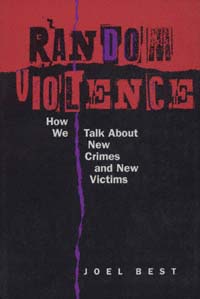 | Title: Random violence: how we talk about new crimes and new victims Author: Best, Joel Published: University of California Press, 1999 Subjects: Sociology | Social Problems | Law | Criminology Publisher's Description: Random Violence is a deft and thought-provoking exploration of the ways we talk about - and why we worry about - new crimes and new forms of victimization. Focusing on so-called random crimes such as freeway shootings, gang violence, hate crimes, stalking, and wilding, Joel Best shows how new crime problems emerge and how some quickly fade from public attention while others spread and become enduring subjects of concern. Best's original and incisive argument illuminates the fact that while these crimes are in actuality neither new, nor epidemic, nor random, the language used to describe them nonetheless shapes both private fears and public policies.Best scrutinizes the melodramatic quality of the American public's attitudes toward crime, exposing the cultural context for the popularity of "random violence" as a catch-all phrase to describe contemporary crime, and the fallacious belief that violence is steadily rising. He points out that the age, race, and sex of homicide victims reveal that violence is highly patterned.Best also details the contemporary ideology of victimization, as well as the social arrangements that create and support a victim industry that can label large numbers of victims. He demonstrates why it has become commonplace to "declare war" on social problems, including drugs, crime, poverty, and cancer, and outlines the complementary influence of media, activists, officials, and experts in institutionalizing crime problems. Intrinsic to all these concerns is the way in which policy choices and outcomes are affected by the language used to describe social problems. [brief] Similar Items |
| 2. | 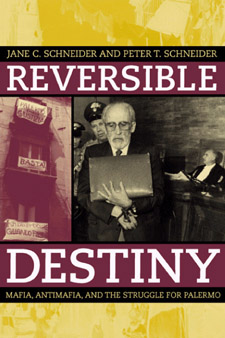 | Title: Reversible destiny: mafia, antimafia, and the struggle for Palermo Author: Schneider, Jane 1938- Published: University of California Press, 2003 Subjects: Anthropology | History | Politics | Criminology | Sociology Publisher's Description: Reversible Destiny traces the history of the Sicilian mafia to its nineteenth-century roots and examines its late twentieth-century involvement in urban real estate and construction as well as drugs. Based on research in the regional capital of Palermo, this book suggests lessons regarding secretive organized crime: its capacity to reproduce a subculture of violence through time, its acquisition of a dense connective web of political and financial protectors during the Cold War era, and the sad reality that repressing it easily risks harming vulnerable people and communities. Charting the efforts of both the judiciary and a citizen's social movement to reverse the mafia's economic, political, and cultural power, the authors establish a framework for understanding both the difficulties and the accomplishments of Sicily's multifaceted antimafia efforts. [brief] Similar Items |
| 3. | 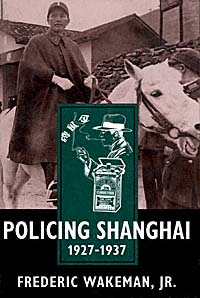 | Title: Policing Shanghai, 1927-1937 Author: Wakeman, Frederic E Published: University of California Press, 1996 Subjects: History | Asian History | China | Urban Studies | Criminology Publisher's Description: Prewar Shanghai: casinos, brothels, Green Gang racketeers, narcotics syndicates, gun-runners, underground Communist assassins, Comitern secret agents. Frederic Wakeman's masterful study of the most colorful and corrupt city in the world at the time provides a panoramic view of the confrontation and collaboration between the Nationalist secret police and the Shanghai underworld.In detailing the life and politics of China's largest urban center during the Guomindang era, Wakeman covers an array of topics: the puritanical social controls implemented by the police; the regional differences that surfaced among Shanghai's Chinese, the influence of imperialism and Western-trained officials. Parts of this book read like a spy novel, with secret police, torture, assassination; and power struggles among the French, International Settlement, and Japanese consular police within Shanghai.Chiang Kai-shek wanted to prove that the Chinese could rule Shanghai and the country by themselves, rather than be exploited and dominated by foreign powers. His efforts to reclaim the crime-ridden city failed, partly because of the outbreak of war with Japan in 1937, but also because the Nationalist police force was itself corrupted by the city.Wakeman's exhaustively researched study is a major contribution to the study of the Nationalist regime and to modern Chinese urban history. It also shows that twentieth-century China has not been characterized by discontinuity, because autocratic government - whether Nationalist or Communist - has prevailed. [brief] Similar Items |
| 4. | 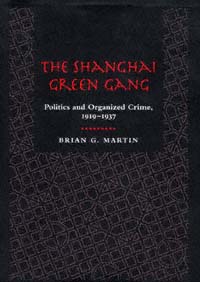 | Title: The Shanghai Green Gang: politics and organized crime, 1919-1937 Author: Martin, Brian G Published: University of California Press, 1996 Subjects: History | Asian History | China | Politics | Criminology Publisher's Description: In a remarkable example of history as detective work, Brian Martin pieces together the fascinating and complex story of the Shanghai Green Gang and its charismatic leader, Du Yuesheng. Martin sifts through a variety of fragmentary and at times contradictory evidence - from diplomatic dispatches to memoirs to police reports - to produce the most comprehensive account of this chaotic period of Chinese history. In analyzing the Green Gang's system of organized crime in Shanghai, the author broadens our understanding of a critical aspect of Chinese urban history and sheds light on the history of drug trafficking and organized crime worldwide.Martin argues that the Green Gang, the most powerful secret society in China during the first half of the twentieth century, was a resilient social organization that adapted successfully to the complex environment of a modernizing urban society. Illustrating its multilayered and complex relations with the bourgeoisie, the industrial proletariat, and the foreign and domestic political authorities, Martin demonstrates how these factors led to the Green Gang's absorption into the corporate state system after 1932. [brief] Similar Items |
| 5. | 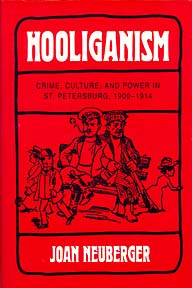 | Title: Hooliganism: crime, culture, and power in St. Petersburg, 1900-1914 Author: Neuberger, Joan Published: University of California Press, 1993 Subjects: History | Politics | Russian and Eastern European Studies | Criminology Publisher's Description: n this pioneering analysis of diffuse underclass anger that simmers in many societies, Joan Neuberger takes us to the streets of St. Petersburg in 1900-1914 to show us how the phenomenon labeled hooliganism came to symbolize all that was wrong with the modern city: increasing hostility between class . . . [more] Similar Items |
| 6. | 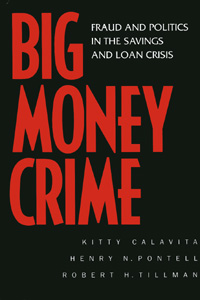 | Title: Big money crime: fraud and politics in the savings and loan crisis Author: Calavita, Kitty Published: University of California Press, 1997 Subjects: Politics | Sociology | Economics and Business | Criminology Publisher's Description: At a cost of $500 billion to American taxpayers, the savings and loan debacle of the 1980s was the worst financial crisis of the twentieth century as well as a crime unparalleled in American history. Yet the vast majority of its perpetrators will never be prosecuted, and those who were have received minimal sentences. In the first in-depth scrutiny of the ways and means of this disaster, this groundbreaking book comes to disturbing conclusions about the deliberate nature of this financial fraud, the political collusion involved, and the leniency of the criminal justice system in dealing with these "Gucci-clad white-collar criminals."Using material from over one hundred interviews with government officials and industry leaders and recently declassified documents, the authors show how - contrary to previous government and "expert" explanations that chalked the disaster up to business risks gone awry or adverse economic conditions - S&L leaders engaged in deliberate fraud, stealing from their own corporations to speculate on high-risk ventures. Tempted by the insurance net, perpetrators looted their own institutions in a new kind of white-collar crime the authors dub "collective embezzlement." Big Money Crime also demonstrates how systematic political collusion - not just policy errors - was a critical ingredient in this unprecedented series of frauds. Bringing together statistics from a variety of government agencies, the authors provide a close reading of the track record of prosecutions and sentencing and find that "suite crime" receives much more lenient treatment than "street crime," despite its significantly higher price tag. The book concludes with a number of modest, but no less urgent, policy recommendations to counter the current deregulatory trend and to avert a replay of the S&L debacle in other financial sectors. FROM THE BOOK :"We built thick walls; we have cameras; we have time clocks on the vaults . . . all these controls were to protect against somebody stealing the cash. Well, you can steal far more money, and take it out the back door. The best way to rob a bank is to own one." - House Committee on Government Operations, 1988 [brief] Similar Items |
| 7. | 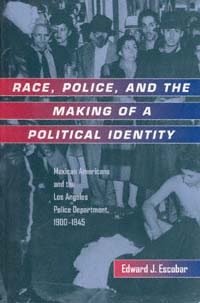 | Title: Race, police, and the making of a political identity: Mexican Americans and the Los Angeles Police Department, 1900-1945 Author: Escobar, Edward J 1946- Published: University of California Press, 1999 Subjects: History | California and the West | Latin American History | Latino Studies | Social Problems | Politics | Californian and Western History | Urban Studies | Criminology | Criminology Publisher's Description: In June 1943, the city of Los Angeles was wrenched apart by the worst rioting it had seen to that point in the twentieth century. Incited by sensational newspaper stories and the growing public hysteria over allegations of widespread Mexican American juvenile crime, scores of American servicemen, joined by civilians and even police officers, roamed the streets of the city in search of young Mexican American men and boys wearing a distinctive style of dress called a Zoot Suit. Once found, the Zoot Suiters were stripped of their clothes, beaten, and left in the street. Over 600 Mexican American youths were arrested. The riots threw a harsh light upon the deteriorating relationship between the Los Angeles Mexican American community and the Los Angeles Police Department in the 1940s.In this study, Edward J. Escobar examines the history of the relationship between the Los Angeles Police Department and the Mexican American community from the turn of the century to the era of the Zoot Suit Riots. Escobar shows the changes in the way police viewed Mexican Americans, increasingly characterizing them as a criminal element, and the corresponding assumption on the part of Mexican Americans that the police were a threat to their community. The broader implications of this relationship are, as Escobar demonstrates, the significance of the role of the police in suppressing labor unrest, the growing connection between ideas about race and criminality, changing public perceptions about Mexican Americans, and the rise of Mexican American political activism. [brief] Similar Items |
| 8. | 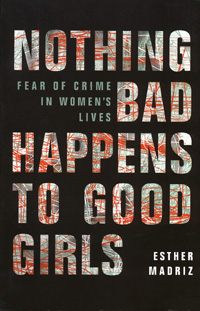 | Title: Nothing bad happens to good girls: fear of crime in women's lives Author: Madriz, Esther 1943- Published: University of California Press, 1997 Subjects: Gender Studies | Sociology | Urban Studies | Women's Studies | Criminology Publisher's Description: "The possibility of being a victim of a crime is ever present on my mind; thinking about it as natural as breathing." - 40-year-old womanThis is a compelling analysis of how women in the United States perceive the threat of crime in their everyday lives and how that perception controls their behavior. Esther Madriz draws on focus groups and in-depth interviews to show the damage that fear can wreak on women of different ages and socioeconomic backgrounds. Although anxiety about crime affects virtually every woman, Madriz shows that race and class position play a role in a woman's sense of vulnerability.Fear of crime has resulted in public demand for stronger and more repressive policies throughout the country. As funds for social programs are cut, Madriz points out, those for more prisons and police are on the increase. She also illustrates how media images of victims - "good" victims aren't culpable, "bad" victims invite trouble - and a tough political stance toward criminals are linked to a general climate of economic uncertainty and conservatism.Madriz argues that fear itself is a strong element in keeping women in subservient and self-limiting social positions. "Policing" themselves, they construct a restricted world that leads to positions of even greater subordination: Being a woman means being vulnerable. Considering the enormous attention given to crime today, including victims' rights and use of public funds, Madriz's informative study is especially timely. [brief] Similar Items |
| 9. | 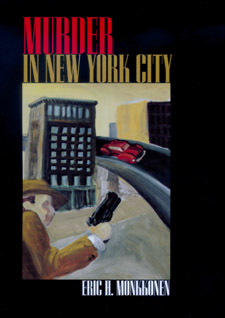 | Title: Murder in New York City Author: Monkkonen, Eric H 1942- Published: University of California Press, 2001 Subjects: American Studies | Psychology | Criminology | United States History Publisher's Description: Murder in New York City dramatically expands what we know about urban homicide, and challenges some of the things we think we know. Eric Monkkonen's unprecedented investigation covers two centuries of murder in America's biggest city, combining newly assembled statistical evidence with many other documentary sources to tease out the story behind the figures. As we generally believe, the last part of the twentieth century was unusually violent, but there have been other high-violence eras as well: the late 1920s and the mid-nineteenth century, the latter because the absence of high-quality weapons and ammunition makes that era's stabbings and beatings seem almost more vicious. Monkkonen's long view allows us to look back to a time when guns were rarer, when poverty was more widespread, and when racial discrimination was more intense, and to ask what difference these things made. With many vivid case studies for illustration, he examines the crucial factors in killing through the years: the weapons of choice, the sex and age of offenders and victims, the circumstances and settings in which homicide tends to occur, and the race and ethnicity of murderers and their victims. In a final chapter, Monkkonen looks to the international context and shows that New York - and, by extension, the United States - has had consistently higher violence levels than London and Liverpool. No single factor, he says, shapes this excessive violence, but exploring the variables of age, ethnicity, weapons, and demography over the long term can lead to hope of changing old patterns. [brief] Similar Items |
| 10. | 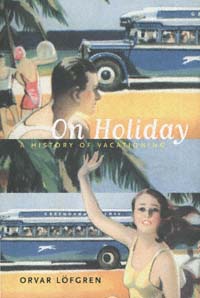 | Title: On holiday: a history of vacationing Author: Löfgren, Orvar Published: University of California Press, 1999 Subjects: History | Anthropology | Travel | American Studies | Cultural Anthropology | Popular Culture | Criminology Publisher's Description: Löfgren takes us on a tour of the Western holiday world and shows how two centuries of "learning to be a tourist" have shaped our own ways of vacationing. We see how fashions in destinations have changed through the years, with popular images (written, drawn, painted, and later photographed) teaching the tourist what to look for and how to experience it. Travelers present and future will never see their cruises, treks, ecotours, round-the-world journeys, or trips to the vacation cottage or condo in quite the same way again. All our land-, sea-, and mindscapes will be the richer for Löfgren's insights. [brief] Similar Items |
| 11. | 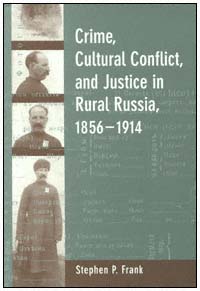 | Title: Crime, cultural conflict, and justice in rural Russia, 1856-1914 Author: Frank, Stephen 1955- Published: University of California Press, 1999 Subjects: History | Russian and Eastern European Studies | Cultural Anthropology | Social Problems | European History | Law | Criminology Publisher's Description: This book is the first to explore the largely unknown world of rural crime and justice in post-emancipation Imperial Russia. Drawing upon previously untapped provincial archives and a wealth of other neglected primary material, Stephen P. Frank offers a major reassessment of the interactions between peasantry and the state in the decades leading up to World War I. Viewing crime and punishment as contested metaphors about social order, his revisionist study documents the varied understandings of criminality and justice that underlay deep conflicts in Russian society, and it contrasts official and elite representations of rural criminality - and of peasants - with the realities of everyday crime at the village level. [brief] Similar Items |